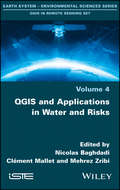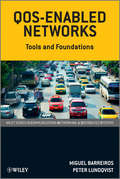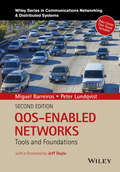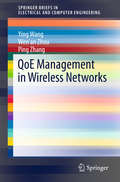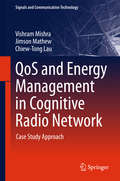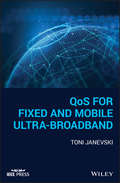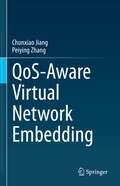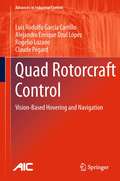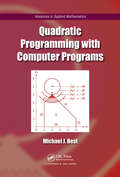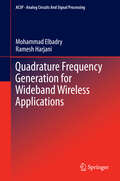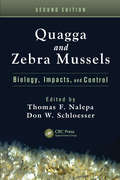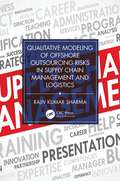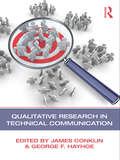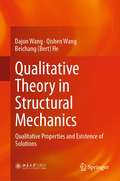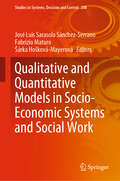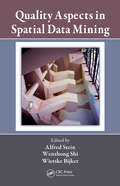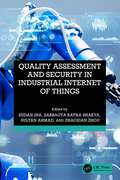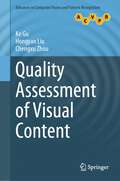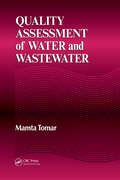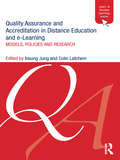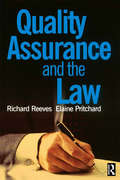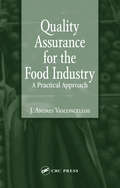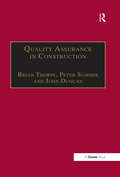- Table View
- List View
QGIS and Applications in Water and Risks
by Nicolas Baghdadi Clément Mallet Mehrez ZribiOur four volumes propose to present innovative thematic applications implemented using the open source software QGIS. These are applications that use remote sensing over continental surfaces. The four volumes detail applications of remote sensing over continental surfaces, with a first one discussing applications for agriculture. A second one presents applications for forest, a third presents applications for the continental hydrology, and finally the last volume details applications for environment and risk issues.
QOS-Enabled Networks
by Miguel Barreiros Peter LundqvistWith a foreword by Kannan Kothandaraman"This is the first book about QOS that I actually enjoyed reading precisely because the authors focused on real-life QoS and not in academic discussions about it."Per Nihlen, IP Network Manager, NORDUnetThe new authoritative, practical guide to delivering QOS guaranteesThis new benchmark in quality of service (QOS) study is written by two experts in the field who deal with QOS predicaments every day. The authors not only provide a lucid understanding of modern theory of QOS mechanisms in packet networks but how to apply them in practice. In addition, they detail the QOS management features found in modern routers used by Internet Service Providers (ISPs) and large enterprise companies and networks, all in an effort to enable network managers and engineers to configure production networks with a quality of service guarantee. The book's focus on addressing network behavior ("real effects") in relation to the configuration of network elements (routers and switches), is both refreshing and insightful.QOS-Enabled Networks contains up-to-date coverage of:QOS mechanisms in packet networks and how to apply them in practiceQOS management features now common in modern-day routersHow network behavior is related to configuration of network elementsLayer 2 VPN and QOSQOS in mobile LTE networksQOS-Enabled Networks is an invaluable guide for networking engineers needing to provide QOS services for service providers, ISPs and large enterprises, as well as for network design and operations engineers.
QOS-Enabled Networks: Tools and Foundations (Wiley Series on Communications Networking & Distributed Systems #37)
by Miguel Barreiros Peter LundqvistWritten by two experts in the field who deal with QOS predicaments every day and now in this 2nd edition give special attention to the realm of Data Centers, QoS Enabled Networks:Tools and Foundations, 2nd Edition provides a lucid understanding of modern QOS theory mechanisms in packet networks and how to apply them in practice. This book is focuses on the tools and foundations of QoS providing the knowledge to understand what benefits QOS offers and what can be built on top of it.
QoE Management in Wireless Networks
by Ping Zhang Ying Wang Wen'An ZhouThis SpringerBrief presents research results on QoE management schemes for mobile services, including user services, and resource allocation. Along with a review of the research literature, it offers a data-driven architecture for personalized QoE management in wireless networks. The primary focus is on introducing efficient personalized character extraction mechanisms, e. g. , context-aware Bayesian graph model, and cooperative QoE management mechanisms. Moreover, in order to demonstrate in the effectiveness of the QoE model, a QoE measurement platform is described and its collected data examined. The brief concludes with a discussion of future research directions. The example mechanisms and the data-driven architecture provide useful insights into the designs of QoE management, and motivate a new line of thinking for users' satisfaction in future wireless networks.
QoS and Energy Management in Cognitive Radio Network
by Jimson Mathew Vishram Mishra Chiew-Tong LauThis book covers the important aspects involved in making cognitive radio devices portable, mobile and green, while also extending their service life. At the same time, it presents a variety of established theories and practices concerning cognitive radio from academia and industry. Cognitive radio can be utilized as a backbone communication medium for wireless devices. To effectively achieve its commercial application, various aspects of quality of service and energy management need to be addressed. The topics covered in the book include energy management and quality of service provisioning at Layer 2 of the protocol stack from the perspectives of medium access control, spectrum selection, and self-coexistence for cognitive radio networks.
QoS for Fixed and Mobile Ultra-Broadband (Wiley - IEEE)
by Toni JanevskiProvides extensive coverage of standardized QoS technologies for fixed and mobile ultra-broadband networks and services—bringing together technical, regulation, and business aspects The Quality of Service (QoS) has been mandatory for traditional telecommunication services such as telephony (voice) and television (TV) since the first half of the past century, however, with the convergence of telecommunication networks and services onto Internet technologies, the QoS provision remains a big challenge for all ICT services, not only for traditional ones. This book covers the standardized QoS technologies for fixed and mobile ultra-broadband networks and services, including the business aspects and QoS regulation framework, which all will have high impact on the ICTs in the current and the following decade. QoS for Fixed and Mobile Ultra-Broadband starts by introducing readers to the telecommunications field and the technology, and the many aspects of both QoS and QoE (Quality of Experience). The next chapter devotes itself to Internet QoS, starting with an overview of numerous technology protocols and finishing with business and regulatory aspects. The next three chapters look at QoS in NGN and Future Networks, QoS for fixed ultra-broadband, and QoS for mobile ultra-broadband. The book also provides readers with in-depth accounts of services in fixed and mobile ultra-broadband; broadband QoS parameters, KPIs, and measurements; network neutrality; and the QoS regulatory framework. Comprehensively covers every aspect of QoS technology for fixed and mobile ultra-broadband networks and services, including the technology, the many regulations, and their applications in business Explains how the QoS is transiting from the traditional telecom world to an all-IP world Presents all the fundamentals of QoS regulation, as well as SLA regulation QoS for Fixed and Mobile Ultra-Broadband is an excellent resource for managers, engineers, and employees from regulators, ICT government organizations, telecommunication companies (operators, service providers), ICT companies, and industry. It is also a good book for students and professors from academia who are interested in understanding, implementation, and regulation of QoS for fixed and mobile ultra-broadband.
QoS-Aware Virtual Network Embedding
by Chunxiao Jiang Peiying ZhangAs an important future network architecture, virtual network architecture has received extensive attention. Virtual network embedding (VNE) is one of the core services of network virtualization (NV). It provides solutions for various network applications from the perspective of virtual network resource allocation. The Internet aims to provide global users with comprehensive coverage. The network function requests of hundreds of millions of end users have brought great pressure to the underlying network architecture. VNE algorithm can provide effective support for the reasonable and efficient allocation of network resources, so as to alleviate the pressure off the Internet. At present, a distinctive feature of the Internet environment is that the quality of service (QoS) requirements of users are differentiated. Different regions, different times, and different users have different network function requirements. Therefore, network resources need to be reasonably allocated according to users' QoS requirements to avoid the waste of network resources. In this book, based on the analysis of the principle of VNE algorithm, we provide a VNE scheme for users with differentiated QoS requirements. We summarize the common user requirements into four categories: security awareness, service awareness, energy awareness, and load balance, and then introduce the specific implementation methods of various differentiated QoS algorithms. This book provides a variety of VNE solutions, including VNE algorithms for single physical domain, VNE algorithms for across multiple physical domains, VNE algorithms based on heuristic method, and VNE algorithms based on machine learning method.
Quad Rotorcraft Control
by Rogelio Lozano Claude Pégard Luis Rodolfo García Carrillo Alejandro Enrique Dzul LópezQuad Rotorcraft Control develops original control methods for the navigation and hovering flight of an autonomous mini-quad-rotor robotic helicopter. These methods use an imaging system and a combination of inertial and altitude sensors to localize and guide the movement of the unmanned aerial vehicle relative to its immediate environment. The history, classification and applications of UAVs are introduced, followed by a description of modelling techniques for quad-rotors and the experimental platform itself. A control strategy for the improvement of attitude stabilization in quad-rotors is then proposed and tested in real-time experiments. The strategy, based on the use low-cost components and with experimentally-established robustness, avoids drift in the UAV's angular position by the addition of an internal control loop to each electronic speed controller ensuring that, during hovering flight, all four motors turn at almost the same speed. The quad-rotor's Euler angles being very close to the origin, other sensors like GPS or image-sensing equipment can be incorporated to perform autonomous positioning or trajectory-tracking tasks. Two vision-based strategies, each designed to deal with a specific kind of mission, are introduced and separately tested. The first stabilizes the quad-rotor over a landing pad on the ground; it extracts the 3-dimensional position using homography estimation and derives translational velocity by optical flow calculation. The second combines colour-extraction and line-detection algorithms to control the quad-rotor's 3-dimensional position and achieves forward velocity regulation during a road-following task. In order to estimate the translational-dynamical characteristics of the quad-rotor (relative position and translational velocity) as they evolve within a building or other unstructured, GPS-deprived environment, imaging, inertial and altitude sensors are combined in a state observer. The text give the reader a current view of the problems encountered in UAV control, specifically those relating to quad-rotor flying machines and it will interest researchers and graduate students working in that field. The vision-based control strategies presented help the reader to a better understanding of how an imaging system can be used to obtain the information required for performance of the hovering and navigation tasks ubiquitous in rotored UAV operation.
Quadratic Programming with Computer Programs (Advances in Applied Mathematics)
by Michael J. BestQuadratic programming is a mathematical technique that allows for the optimization of a quadratic function in several variables. QP is a subset of Operations Research and is the next higher lever of sophistication than Linear Programming. It is a key mathematical tool in Portfolio Optimization and structural plasticity. This is useful in Civil Engineering as well as Statistics.
Quadrature Frequency Generation for Wideband Wireless Applications
by Ramesh Harjani Mohammad ElbadryThis book describes design techniques for wideband quadrature LO generation for software defined radio transceivers, with frequencies spanning 4GHz to around 80GHz. The authors discuss several techniques that can be used to reduce the cost and/or power consumption of one of the key component of the RF front-end, the quadrature local oscillator. The discussion includes simple and useful insights into quadrature VCOs, along with numerous examples of practical techniques.
Quadrature RC−Oscillators: The Van Der Pol Approach (Analog Circuits And Signal Processing Series)
by Igor M. Filanovsky João Carlos Casaleiro Luís Augusto OliveiraThis book presents a tutorial review of van der Pol model, a universal oscillator model for the analysis of modern RC−oscillators in weak and strong nonlinear regimes. A detailed analysis of the injection locking in van der Pol oscillators is also presented. The relation between the van der Pol parameters and several circuit implementations in CMOS nanotechnology is given, showing that this theory is very useful in the optimization of oscillator key parameters, such as: frequency, amplitude and phase relationship. The authors discuss three different examples: active coupling RC−oscillators, capacitive coupling RC−oscillators, and two-integrator oscillator working in the sinusoidal regime. · Provides a detailed tutorial on the van der Pol oscillator model, which can be the basis for the analysis of modern RC−oscillators in weak and strong nonlinear regimes; · Demonstrations the relationship between the van der Pol parameters and several circuit implementations in CMOS nanotechnology, showing that this theory is a powerful tool in the optimization of key oscillator parameters; · Provides three circuit prototypes implemented in modern CMOS nanotechnology in the GHz range, with applications in low area, low power, low cost, wireless sensor network (WSN) applications (e.g. IoT, BLE).
Quagga and Zebra Mussels: Biology, Impacts, and Control, Second Edition
by Thomas F. Nalepa Don W. SchloesserThe introduction and rapid spread of two Eurasian mussel species, Dreissena polymorpha (zebra mussel) and Dreissena rostriformis bugensis (quagga mussel), in waters of North America has caused great concern among industrial and recreational water users. These invasive species can create substantial problems for raw water users such as water treatme
Qualitative Modeling of Offshore Outsourcing Risks in Supply Chain Management and Logistics
by Rajiv Kumar SharmaWhat are the biggest challenges facing those managing supply chains? Qualitative Modeling of Offshore Outsourcing Risks in Supply Chain Management and Logistics is intended to benefit the stakeholders in client organizations by raising their understanding and awareness about the most dominant risks. This will equip supply chain managers to give more emphasis to mitigating these risks. It further showcases the development and validation of a conceptual framework that depicts the relationship among key offshore outsourcing risks. The text explores modelling various risks which disrupt the automotive supply chain and cybersecurity breaches in digital supply chains.This book: Covers structural modelling of key offshore outsourcing risks for understanding their driving and dependence power. Presents a conceptual framework and hierarchical structural model for perfect order fulfilment in both upstream and downstream supply chains. Explores the challenges in handling operational risks associated with poor delivery performance or service quality. Models dimensions which affect vendor selection in offshore outsourcing environment. Investigates cultural influences on the management of geographically distributed operations in offshore outsourcing. Addresses the workforce-related offshore outsourcing risk such as loss of key professionals. Discusses the risk associated with selection of location, viz. distribution centres/warehouses in supply chain and logistics. Models dimensions related to cybersecurity breaches in digital supply chains because of IT offshoring. It is aimed at senior undergraduate and graduate students, and academic researchers in the fields of manufacturing engineering, industrial engineering, mechanical engineering, supply chain management and production engineering.
Qualitative Research in Technical Communication
by James Conklin George F. HayhoeAddressing the explosive growth in qualitative research in recent years, this volume represents the first anthology to bring together a representative sample from this growing body of work, and comments on the reasons for the extraordinary interest in qualitative research. Contributors to the volume bring forward reports of significant, structured qualitative research into various aspects of technical communication practice, addressing the questions of what new insights researchers are generating about the working reality of today’s technical communicators, and how technical communicators are perceived and treated by managers and by colleagues from other disciplines. Including examples of qualitative methodologies—including ethnography, case study, focus groups, action research, grounded theory, and interview research— used by technical communicators to strengthen their practice, the result is a rich harmony of perspectives, as diverse as the field of technical communication itself. This book will be of interest to to students and academics seeking up-to-date information on current industry practices in technical communication, as well as to practitioners in technical and professional communication. The book will also serve as a text in undergraduate seminars and courses at the master’s level.
Qualitative Theory in Structural Mechanics: Qualitative Properties and Existence of Solutions
by Dajun Wang Qishen Wang Beichang (Bert) HeThis book focuses on the qualitative theory in structural mechanics, an area that remains underdeveloped. The qualitative theory mainly deals with the static deformation and vibrational modes of linear elastic structures, and cover subjects such as qualitative properties and the existence of solutions.Qualitative properties belong to one type of structure, are at the system level and of clear regularity, and often result from analytical derivation and logical reasoning. As for the existence of solutions, it addresses a fundamental issue in structural mechanics, and has far-reaching implications for engineering applications.A better understanding of qualitative properties can assist in both numerical computation and experimental studies. It also promotes the development of better dynamic designs for structures. At the same time, a sound grasp of the existence of solutions and related subjects can aid in quantitative analysis, and help researchers establish the theoretical background essential to their work. This book is among the few that is dedicated exclusively to the qualitative theory in structural mechanics and systematically introduces the important and challenging area to a wide audience, including graduate students in engineering.
Qualitative and Quantitative Models in Socio-Economic Systems and Social Work (Studies in Systems, Decision and Control #208)
by Šárka Hošková-Mayerová Fabrizio Maturo José Luis Sarasola Sánchez-SerranoThe main purpose of this book is not only to present recent studies and advances in the field of social science research, but also to stimulate discussion on related practical issues concerning statistics, mathematics, and economics. Accordingly, a broad range of tools and techniques that can be used to solve problems on these topics are presented in detail in this book, which offers an ideal reference work for all researchers interested in effective quantitative and qualitative tools. The content is divided into three major sections. The first, which is titled “Social work”, collects papers on problems related to the social sciences, e.g. social cohesion, health, and digital technologies. Papers in the second part, “Education and teaching issues,” address qualitative aspects, education, learning, violence, diversity, disability, and ageing, while the book’s final part, “Recent trends in qualitative and quantitative models for socio-economic systems and social work”, features contributions on both qualitative and quantitative issues. The book is based on a scientific collaboration, in the social sciences, mathematics, statistics, and economics, among experts from the “Pablo de Olavide” University of Seville (Spain), the “University of Defence” of Brno (Czech Republic), the “G. D’Annunzio” University of Chieti-Pescara (Italy) and “Alexandru Ioan Cuza University” of Iaşi (Romania). The contributions, which have been selected using a peer-review process, examine a wide variety of topics related to the social sciences in general, while also highlighting new and intriguing empirical research conducted in various countries. Given its scope, the book will appeal, in equal measure, to sociologists, mathematicians, statisticians and philosophers, and more generally to scholars and specialists in related fields.
Quality Aspects in Spatial Data Mining
by Wenzhong Shi Alfred Stein Wietske BijkerDescribes the State-of-the-Art in Spatial Data Mining, Focuses on Data QualitySubstantial progress has been made toward developing effective techniques for spatial information processing in recent years. This science deals with models of reality in a GIS, however, and not with reality itself. Therefore, spatial information processes are often impre
Quality Assessment and Security in Industrial Internet of Things
by Sudan Jha Sultan Ahmad Sarbagya Ratna Shakya Zhaoxian ZhouThis book highlights authentication and trust evaluation models in the Industrial Internet of Things. It further discusses data breaches and security issues in various Artificial Intelligence-enabled systems and uses Blockchain to resolve the challenges faced by the Industrial Internet of Things. The text showcases performance quality assessment for the Industrial Internet of Things’ applications.This book: Discusses and evaluates different quality assessment systems and authentication of smart devices Addresses data handling, data security, confidentiality, and integrity of data in the Industrial Internet of Things Focuses on developing framework and standardization of quality assessment for diverse Internet of Things-enabled devices Explains the designing, developing, and framing of smart machines, that are equipped with tools for tracking and logging data to provide advanced security features Presents the convergence of the Internet of Things toward Industry 4.0 through quality assessment via analyzing data security and identifying vulnerabilities It is primarily written for graduate students and academic researchers in the fields of electrical engineering, electronics, and communications engineering, industrial and production engineering, computer science, and engineering.
Quality Assessment of Visual Content (Advances in Computer Vision and Pattern Recognition)
by Hongyan Liu Ke Gu Chengxu ZhouThis book provides readers with a comprehensive review of image quality assessment technology, particularly applications on screen content images, 3D-synthesized images, sonar images, enhanced images, light-field images, VR images, and super-resolution images. It covers topics containing structural variation analysis, sparse reference information, multiscale natural scene statistical analysis, task and visual perception, contour degradation measurement, spatial angular measurement, local and global assessment metrics, and more. All of the image quality assessment algorithms of this book have a high efficiency with better performance compared to other image quality assessment algorithms, and the performance of these approaches mentioned above can be demonstrated by the results of experiments on real-world images. On the basis of this, those interested in relevant fields can use the results obtained through these quality assessment algorithms for further image processing. The goal of this book is to facilitate the use of these image quality assessment algorithms by engineers and scientists from various disciplines, such as optics, electronics, math, photography techniques and computation techniques. The book can serve as a reference for graduate students who are interested in image quality assessment techniques, for front-line researchers practicing these methods, and for domain experts working in this area or conducting related application development.
Quality Assessment of Water and Wastewater
by Mamta TomarWater is the most basic need of mankind. Drinking water is considered the most essential use of water in life. Therefore it must be free of pathogens, toxins and carcinogens. Absolutley pure water does not exist in nature. Surface water absorbs particles, carbon dioxide and other gases and mixes with silt and inorganic matters from the envir
Quality Assurance and Accreditation in Distance Education and e-Learning: Models, Policies and Research (Open and Flexible Learning Series)
by Insung Jung Colin LatchemQuality assurance (QA) in open and distance learning (ODL) can be a contentious issue. Some argue that it should be judged by the same criteria and methods as face-to-face education, while others claim that it is so different in its organization, enrolments and operations that conventional QA mechanisms cannot apply. Some advocate the use of specific guidelines and standards for e-learning; others believe that, regardless of the technology, the basic principles of quality teaching and learning should apply. Providers who have enjoyed freedom from external scrutiny may resist attempts at external regulation and auditing and look upon QA as yet another imposition of corporatization and bureaucracy on education. Others see it as a means of establishing a culture of quality, self-reflection and self-improvement. There is little research-based literature to guide policy-makers, managers and practitioners in applying QA in education and training to ensure the right balance is found between accountability and autonomy, as well as assuring quality for the time and costs involved. In this respect, Quality Assurance and Accreditation in Distance Education and e-Learning is a book that is long overdue. It explains what is involved in QA and accreditation in education. It describes and analyzes applications of these practices in open, distance, dual-mode and conventional universities throughout Europe, North America, Africa, and the Asia-Pacific, looking at open schooling, e-learning in conventional schools, non-formal adult and community education, and corporate and small-to-medium enterprises. Quality Assurance and Accreditation in Distance Education and e-Learning is edited and authored by experts with extensive international experience in ODL, e-learning and QA who give careful consideration to the possibilities and challenges involved. The book will be an invaluable guide for all policy-makers, managers, practitioners and researchers in the field.
Quality Assurance and the Law
by Richard Reeves Elaine PritchardOver the last 25 years there has been a considerable increase in the awareness of quality related issues. In the world of business and commerce, this awareness has manifested itself in the development of what was the British Quality Standard BS 5750 into what is now the international standard BS EN ISO 9000. Alongside all of this, consumers in general have developed increasingly demanding expectations with regard to the quality of goods and services available in the market place. During a similar period there has also been an increase in legislation, together with an expansion of the common law, which has strengthened the protection already afforded to the consumer. This book will provide quality practitioners, managers and those with a general interest in quality, with an insight into the legal issues involved. In addition, the book shows how the implementation of a Quality Assurance Management System - such as that required in order to be registered as a firm of assessed capability, in accordance with BS EN ISO 9000 - can act as an aid to businesses seeking to comply with their legal obligations.In addition, for those following a formal course of study, the contents will prove to be particularly useful to students undertaking the Institute of Quality Assurance's Associate Membership examination: Principles and Techniques of Quality Assurance.
Quality Assurance for the Food Industry: A Practical Approach
by J. Andres VasconcellosFood companies, regardless of their size and scope, understand that it is impossible to establish a single division devoted to "quality", as quality is the responsibility and purpose of every company employee. Applying this theory demands the cooperation of each employee and an understanding of the methodology necessary to establish, implement, and
Quality Assurance in Construction
by Peter Sumner Brian ThorpeThe need for quality assurance in construction is now widely accepted. As a result, pressure is currently being applied to contractors and those offering professional services to demonstrate QA capability prior to commission. This book, written by experts in the field of quality management, shows how construction companies can effectively apply QA within their own organization. It pinpoints the real benefits to be gained from developing well-structured systems and offers practical guidance on implementation techniques. Inevitably, quality management standards play an important role in helping to define the requirements of any QA system. With this in mind the authors provide a detailed analysis of ISO 9000 - 1994 and its implementation. The text is complemented by numerous diagrams and examples and is essential reading for all construction professionals concerned with quality.
Quality Assurance in Distance Education and E-learning
by Tat Meng Wong Insung Jung Tian BelawatiQuality Assurance in Distance Education and E-Learning: Challenges and Solutions from Asia documents the existing regulatory framework covering quality assurance (QA) systems in distance education (DE) in a number of Asian countries. It draws on the knowledge and experience of 16 selected DE/e-learning institutions of Asia and reveals the respective development of QA systems and procedures within these providers/programmes. The endeavour towards developing QA systems through various stages of testing and development is in response to the growing public concern for the quality of DE as well as staff aspirations for quality. This book, through the selection of cases from the aforementioned institutions, covers a wide range of QA systems and perspectives of quality in DE. These cases present good practices in QA for DE/e-learning, analyse challenges in assuring the quality of DE products and services, offer possible solutions to meet those challenges, and present lessons for other DE providers.
